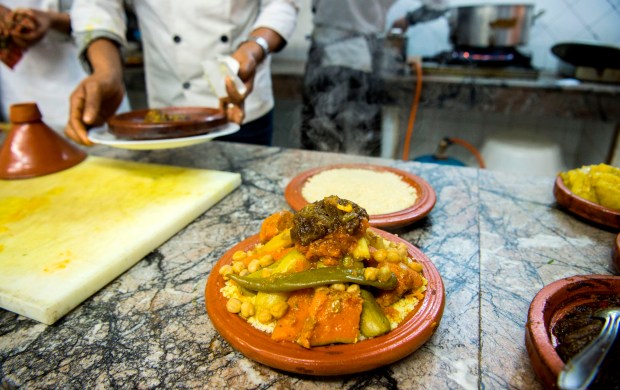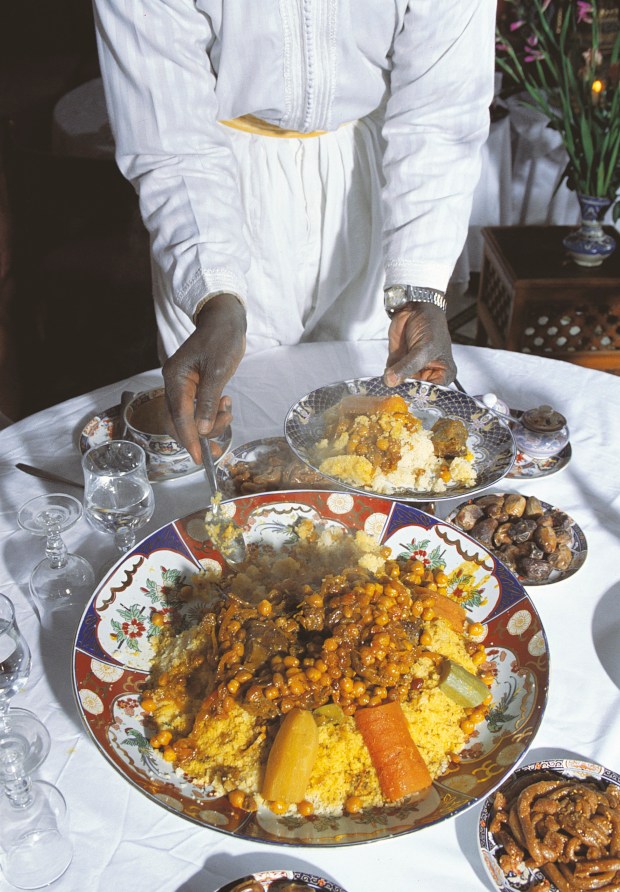The first time I tried couscous, it came from a deli counter. That was mistake No. 1.
It had dried cranberries (mistake No. 2), chopped celery (mistake No. 3), slivered almonds (mistake No. 4), and it was served chilled (perhaps the unholiest of couscous sins).
More than 20 years later, I ate real couscous for the first time at an Algerian restaurant in Paris. And while visiting Morocco several years after that, I learned how to properly eat the North African staple.
Real couscous is fluffy, not chewy. It’s steamed, not boiled. And it is anything but instant, taking up to five hours to make when cooked properly. (The semolina granules must be steamed multiple times.) Forget about couscous being a Tupperware, grab-and-go lunch fix. The real deal requires work. But it is a labor of love.
In Morocco that labor can be seen (and smelled) being prepared in every town across the country on one day in particular: Fridays, the holiest day of the week in the Muslim world.
I was working on a story at a small nongovernmental organization in the southern city of Agadir one Friday morning when the director stopped me in the corridor.
“No breakfast. It’s couscous day,” she said.
It was barely 9 a.m., but already the office cook, Hadda, was busy in the kitchen peeling vegetables. Piles of carrots, zucchini, turnips, pumpkin, and cabbage began to layer on the table.
In the room next door, several staff members and I pretended to work, when really all we did was talk about the dish we were patiently waiting to devour.
“Sometimes, she makes it tfaya style, with caramelized onions and raisins,” Tasnim, a young Moroccan-American employee, told me with excitement.

Different countries across North Africa claim ownership of couscous. But its origins are tied to the Berber, or Amazigh, ethnic group, which has belonged to the region since long before Arab migration.
References to something that resembled the dish date back to the seventh century, when Berbers would prepare a dish made of wheat, millet, and barley, kneaded with water or milk.
Archaeologists have even found what they believe to be couscous-making utensils in tombs dating back to the third century B.C., during the rule of King Masinissa, known as the forefather of the Berbers.
“It’s fluffing!” I heard the director yell with excitement. It was nearly noon, so I peeked into the kitchen in the hope that meant it was time to dig in. It wasn’t.
The couscous would need to be steamed at least another two times before it was fully cooked. I could hear my stomach starting to yell at me for skipping breakfast.
Wherever its origins, not much has changed about the method for cooking proper couscous in the last few centuries.
To steam the granules, Hadda would use two stacked pots, known as a couscousière in French or kiskis in Arabic. The bottom, larger pot holds the meat (in that first day’s case, chicken, though it could also be lamb) and vegetables while they simmer in a flavorful broth. Meanwhile, the couscous granules are steamed in the top pot, which has little holes in the bottom like a colander. A cheesecloth is placed between the two pots.
After each steam, Hadda would gently pick up the couscous and feel the texture, slowly releasing the granules back into the pot.
Hadda was patient and calm. My stomach, on the other hand, was becoming only more audibly irritable.
In January 2018, a group of experts from Morocco, Algeria, and Tunisia announced they were considering submitting a joint proposal to add couscous to UNESCO’s Intangible Cultural Heritage List.
In a region that has been fighting over various cultural ownerships for millenniums, this move was a game changer. Was this an official acknowledgment that they all had an equal stake in this tasty dish? That it was a shared heritage?

Talk about food diplomacy.
That day at the NGO, all I could think about was food deprivation. It was after 2 p.m., and the beautiful aroma coming from the kitchen was only making things worse.
“It’s ready!” someone shouted, and I ran to the kitchen. It still wasn’t.
My selfishness and gluttony were quickly overtaking my appreciation for all of Hadda’s hard work.
Then someone handed me a spoon and offered me one of the six seats around the small kitchen table.
Before our eyes appeared a giant communal platter of the fluffy couscous, with layers of the tender vegetables scattered on top and the chicken hidden underneath.
“Besseha,” Hadda said, smiling as she poured a ladle of the fragrant broth over the dish.
After five minutes of nonstop eating in silence, we sat back and laughed at our greedy stomachs. With our bellies satisfied, Hadda suggested I ditch my spoon and eat couscous the Moroccan way.
“Avec les mains,” she said, making a scooping motion with her hand.
“See, now you’re having the full experience,” said Tasnim, giving me a thumbs-up for my no-utensil work.
“No, if she wants the full experience, she needs to be invited to someone’s home for Friday couscous,” someone interjected.
Before I could respond, I had offers from all around the table for the next week. Though next time, I was going to be involved in the cooking as well.